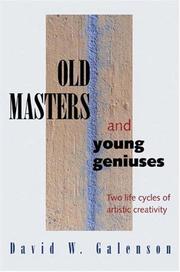| Listing 1 - 1 of 1 |
Sort by
|

ISBN: 0691121095 9780691121093 0691133808 9786613133397 1400837391 1283133393 9781400837397 9780691133805 9781283133395 6613133396 Year: 2006 Publisher: Princeton, N.J. Princeton University Press
Abstract | Keywords | Export | Availability | Bookmark
 Loading...
Loading...Choose an application
- Reference Manager
- EndNote
- RefWorks (Direct export to RefWorks)
When in their lives do great artists produce their greatest art? Do they strive for creative perfection throughout decades of painstaking and frustrating experimentation, or do they achieve it confidently and decisively, through meticulous planning that yields masterpieces early in their lives? By examining the careers not only of great painters but also of important sculptors, poets, novelists, and movie directors, Old Masters and Young Geniuses offers a profound new understanding of artistic creativity. Using a wide range of evidence, David Galenson demonstrates that there are two fundamentally different approaches to innovation, and that each is associated with a distinct pattern of discovery over a lifetime. Experimental innovators work by trial and error, and arrive at their major contributions gradually, late in life. In contrast, conceptual innovators make sudden breakthroughs by formulating new ideas, usually at an early age. Galenson shows why such artists as Michelangelo, Rembrandt, Cézanne, Jackson Pollock, Virginia Woolf, Robert Frost, and Alfred Hitchcock were experimental old masters, and why Vermeer, van Gogh, Picasso, Herman Melville, James Joyce, Sylvia Plath, and Orson Welles were conceptual young geniuses. He also explains how this changes our understanding of art and its past. Experimental innovators seek, and conceptual innovators find. By illuminating the differences between them, this pioneering book provides vivid new insights into the mysterious processes of human creativity.
Ability [Influence of age on ] --- Age and ability --- Age factors in ability --- Aptitude [Influence de l'âge sur l'] --- Bekwaamheid [Invloed van ouderdom op ] --- Creatie (Literaire, artistieke, enz.) --- Creation (Literary, artistic, etc.) --- Creative ability in art --- Création (esthétique) --- Création artistique --- Création littéraire, artistique, etc. --- Schepping (Literaire, artistieke, enz.) --- Ability, Influence of age on. --- Création (Arts) --- Facteurs liés à l'âge --- Création (Arts) --- Facteurs liés à l'âge --- Arts, Modern --- Mind and body --- Age and employment --- Creative ability in literature --- Art --- Imagination --- Inspiration --- Literature --- Creative ability --- Originality --- anno 1900-1999 --- anno 1800-1899 --- Aptitude --- Arts --- Arts [Modern ] --- 19th century --- Art [Modern ] --- 20th century
| Listing 1 - 1 of 1 |
Sort by
|

 Search
Search Feedback
Feedback About UniCat
About UniCat  Help
Help News
News